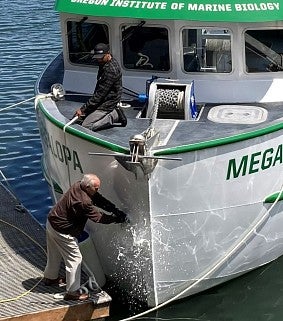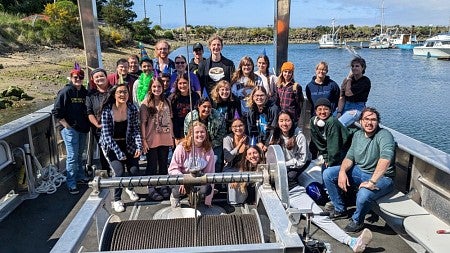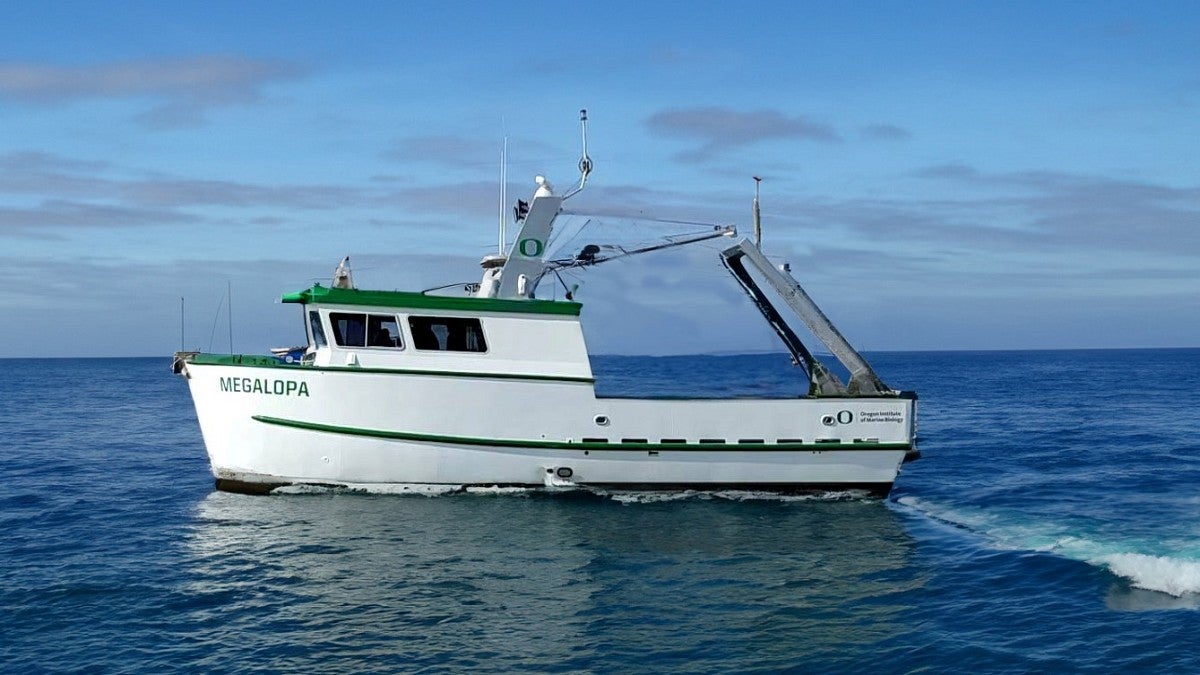After more than four years of fundraising, design and fabrication, the Oregon Institute of Marine Biology christened a new boat that promises to reveal lesser-known regions of the sea to future generations of students and scientists at the University of Oregon.
Built near the university’s marine laboratory in Charleston, research vessel Megalopa replaces the Pluteus, a 1973 vintage boat that the institute had both outgrown and outworn. The institute is one of four in the Department of Biology of UO’s College of Arts and Sciences. It will celebrate its centennial next year as one of the oldest marine laboratories on the west coast.
The Charleston campus is a destination for students, scholars and visitors who can study and experience the distinct marine environment. Interest in marine biology is on the rise, especially among out-of-state students; more than 350 majors are enrolled, twice as many as a decade ago. OIMB, as the institute is known, recently came under the administration of the college, whose students will benefit in new ways.
“The OIMB offers a wonderful undergraduate experience in marine biology with small courses, hands-on labs and field work,” said Chris Poulsen, Tykeson Dean of the College of Arts and Sciences. “Our intent is to increase opportunities for both students and faculty to visit and take advantage of the resources and environment.”
The institute’s scientists rely on boats to access coastal waters and the organisms that live there. The new boat will serve as a safer, faster and larger base for instruments to sample the marine environment and record its conditions, for gathering specimens, and for research with scuba.

“This new boat is central to both the teaching and the research mission of OIMB,” said Craig Young, the institute director. “A research vessel serves as a floating classroom, providing a level of student experience that cannot be obtained in any other way. It will also be a unique and important resource for marine research on the South Coast.”
Resembling a fishing boat from above water, Megalopa doesn’t hold crabs or fish below deck, but instead houses equipment like a Seakeeper gyroscope, which stabilizes the boat to mitigate seasickness, a large cable winch for an underwater drone and a large digital screen for viewing live underwater video.
The institute’s drone was purchased with a NSF grant several years ago but operating it from Pluteus required keeping the boat in one position on the water, a huge challenge in Pacific Northwest tides. The new boat has front propellers and a special trolling valve that keep the boat stationary while the remotely operated vehicle is working below.
On the old boat, students took turns crowding around an 8-inch monitor to view the ocean floor. Megalopa has a seating area that allows groups of up to 30 students to view the action on a 40-inch screen.
Hydraulic rams lift the cable reel onto the deck only when needed, saving space. Hydraulics also power a large A-frame that arches over the stern, lifting the drone and other equipment in and out of the water safely.
Finally, the new boat has large fuel tanks and a powerful engine capable of taking researchers and students 20-30 miles offshore in a single day, placing it within reach of some of the least-understood parts of the Oregon continental shelf. This access has the potential to benefit the world through its discoveries.
“The continental shelf off Oregon is not very well known at all,” Young explained. “We know much about the deep sea because we can access it with advanced human-occupied submersibles, and we know quite a bit about the shallower depths accessible by scuba. The intermediate depths between about 100 and 2,000 feet are arguably the least studied parts of the ocean. This new boat is specially designed for working at these depths.”
Financing the boat, which is valued at more than $1.5 million, was a multi-year, statewide effort involving private donors, the Coos County Commission, the Oregon Legislature and the UO. Both local and state governments recognize the importance of the institute to both the economy and education in Southern Oregon.
Dennis Beetham, a Coos County CEO, former OIMB student and generous benefactor of the UO, made the first donation toward the vessel, said Young. Beetham smashed a bottle of bubbly over the bow of the boat Saturday, June 10, at the official christening on the institute’s campus. With an estimated 200 in attendance, the jubilant celebration featured a picnic of seafood donated by the Oregon Dungeness Crab and Albacore Commissions. Crab cakes, shrimp cocktail, clam chowder, grilled albacore and salads were on the menu, followed by cake decorated with pictures of Megalopa.
Megalopa is a term used by scientists to denote the juvenile stage of a crab, in this case a nod to both Oregon’s most important fishery and to OIMB’s research in larval biology. “OIMB is famous for its work on animal babies,” said Young.
The retiring research vessel Pluteus was named for a larval sea urchin. While keeping the tradition of a larval name, Young sought the input of both the Confederated Tribes of Coos, Lower Umpqua and Siuslaw Indians and the Coquille Indian Tribe, on whose land the OIMB now sits. The tribes and the institute considered various baby animal names in the Indigenous Miluk language, eventually choosing the baby crab name. Due to a technical requirement from the US Coast Guard related to pronunciation marks in the language, the Miluk name could not be used as the official name of the boat, so the standard scientific name, Megalopa, was used instead.

The advantages the institute will enjoy thanks to Megalopa will ultimately benefit not only the local community, to whom the Charleston Marine Life Center at OIMB is a source of economic and educational impact as well as pride, but also state agencies and the international academic community, Young said. “OIMB provides a venue for teaching and research for people from all over the U.S. and abroad. All those visitors will now have a safer, better boat.”
─ By Anna Glavash Miller, College of Arts and Sciences
─ Photo credits: Jessica Young (AI-generated image of Megalopa at sea, christening); Craig Young (OIMB class)


